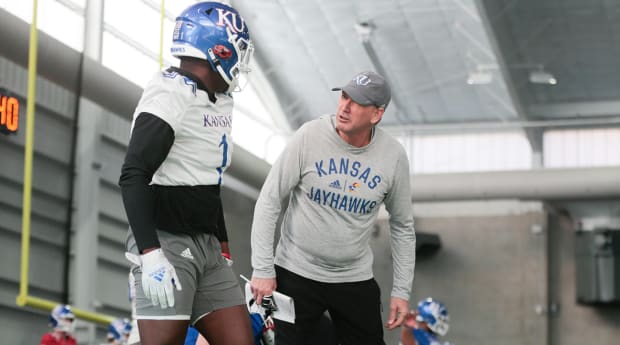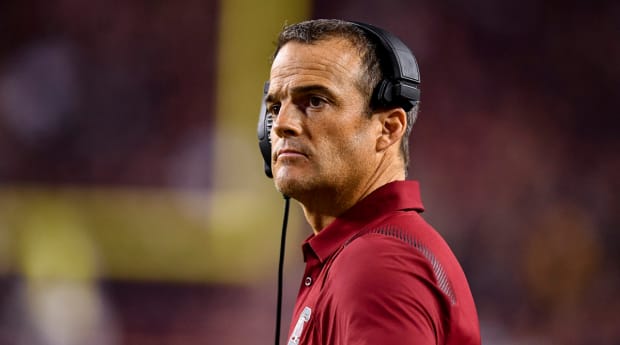Like many first-year coaches, Shane Beamer dealt with roster turnover last season that put his South Carolina team shy of reaching full capacity.
The Gamecocks entered the 2021 season having 79 players on scholarship—six short of the maximum 85 spots allowed by the NCAA. And yet, those six scholarships—fully paid tuition, books and fees—were never used because of the NCAA’s annual signing limit policy, which restricts schools to signing no more than 25 new players every year.
“I couldn’t get my roster back up to 85 to be competitive [numerically],” Beamer says. “That’s six unused scholarships.”
Kansas coach Lance Leipold is dealing with something much worse. The Jayhawks, pending more transfer movement this summer, will enter next season in the low 70s in roster numbers. That’s more than a dozen unused scholarships.
“Is that a safety issue?” Leipold asks. “You're worried about your numbers and depth and you’re playing players you wish you had more time with or had redshirted.”

Evert Nelson/The Capital-Journal/USA TODAY Sports
Many within the college football industry say it’s time the 25-man signing policy changes. Soon, that could happen. College leaders are exploring what would be yet another groundbreaking change in an era of transformation within the industry: the elimination of annual signing limits in football. Under the concept, teams could sign an unlimited number of players each year as long as they remain at or below the NCAA-maximum 85 scholarships.
The discussions are serious enough that such a proposal has been widely socialized among coaches and athletic administrators, some of whom believe the issue has a legitimate shot at passing in time for this upcoming signing class. Signing caps are expected to be a central discussion topic starting next month, when a slew of FBS conference meetings transpires—the first of which begins Monday in Phoenix with the Big 12, Mountain West, Pac-12 and Big Ten.
There is plenty of pushback against the proposal. While eschewing annual signing limits would provide schools a solvent to an increasingly difficult problem—managing a roster in the age of excessive transfers—skeptics have worries. For starters, will the plan further open the door for coaches to purposely turn over their rosters by cutting players and replacing them with signing classes of upwards of 40?
It’s a concern from many administrators and some coaches alike. However, the exodus of players into the transfer portal combined with signing limitations has prevented many programs from reaching the 85-scholarship mark. The rate of transfers, at its highest in college football history, has many schools entering next season down more than 10 scholarship spots and others in the 60s, more than 20 shy of the 85 number, coaches say.
It’s a “necessity” to get rid of the yearly signing cap, says former Duke coach David Cutcliffe, now in an administrative role with the SEC office. “There’s no way to manage your roster,” he says. “There are teams out there scared to death of having a couple of injuries at a certain position and they might not be able to play.”
For example, Texas and Penn State are battling enough offensive line depth issues this spring that they adjusted their spring game formats. The Longhorns don’t have enough O-linemen to even assemble two five-man units. Several schools went a step further: They abandoned spring games altogether.

Aaron E. Martinez/American-Statesman/USA TODAY Sports
Eliminating the signing cap would be the second change to the policy since last summer. In 2021, coaches were allowed to replace up to seven players who entered the transfer portal, increasing the 25-person limit to as many as 32.
It was never meant as a permanent solution, but a one-year stopgap until a more permanent policy is in place. At a time of transition within the NCAA, the dissolution of the signing cap may not be a permanent solution, either. The proposal may serve as a sort-of trial run for possibly two years, at which point the results could be reviewed, administrators say. A signing cap could be reimposed at some point.
The full-scale cutting of the signing cap isn’t the only concept on the table, officials say. Maybe the 25-plus-7 (32) plan will be extended. Or maybe a “one-for-one” plan is instituted, allowing coaches to replace each transferring player with no limit.
“We have to do something,” says Neal Brown, the West Virginia coach who serves on the American Football Coaches Association board of directors. “The current system doesn’t work. It’s extremely difficult to get to your 85 without putting walk-ons on scholarship.”
Proponents say change is needed immediately to prevent serious depth issues that could impact a game or even result in a canceled contest similar to the pandemic-impacted 2020 season. During that year, in light of COVID-19-related positives, teams needed to meet certain roster thresholds to compete. In the SEC, for instance, teams needed 53 healthy players and at least seven healthy offensive linemen.
Todd Berry, executive director of the AFCA, says he’s spoken to one unnamed coach whose roster is currently at 62, and that includes the latest signing class.
“Our coaches have always been in support of the 25,” Berry says, “but the landscape has changed. All of our coaches have recognized that it’s not realistic anymore. From a health-and-safety standpoint, the only way to allow us to get to a situation to have the right amount of players at positions is to just get to 85.”
Even those previously reluctant are warming up to the idea. Eliminating the signing cap is a realistic option to provide “flexibility” for coaches whose rosters are left with holes from the high transfer movement, says Shane Lyons, the West Virginia athletic director who chairs the NCAA Division I Council.
While the 25-player cap provides wiggle room for natural attrition (100 signees over four years is a 15-player excess of 85), an NCAA rule change last spring opened the door to increased attrition. The change granted athletes the right to transfer once without penalty, leading to a flood of players into the transfer portal, now in its fourth year of existence.
A year later, the exodus is at an all-time high, says Brian Spilbeler, co-founder of Tracking Football, an advanced scouting analysis company that examines players in the portal. Since Aug. 1, the start of the 2021–22 portal cycle, more than 6,400 players have entered the database from all three divisions—2,500 of those from FBS. That’s 100 shy of matching last year’s FBS total with four months remaining in the cycle.
Spilbeler expects to shatter that mark by May. In a three-day span from April 18 to 20, the immediate days after many teams completed spring practice, about 120 D-I players entered the database.
Teams are losing more players than they are technically allowed to bring back, Spilbeler says, because of the annual signing limit.
“There’s got to be something done for teams to fill the needs. Some of the losses they cannot control,” he says. “The amount of roster turnover will continue to go up regardless.”
Still, there are potential problems with scrapping the signing cap. “The thing that concerns me is that coaches will be flipping rosters constantly and potentially running kids off,” Lyons says. “That’s why we got the caps. You have to go back in history and ask, ‘How did we get here?’”
The annual signing limit in football has for years been an argumentative issue. It was originally implemented to disincentivize the trend of coaches cutting or pushing out scholarship players in an effort to oversign high school players or transfers.
The transfer surge combined with name, image and likeness (NIL) is resulting in another disturbing trend: coaches steering their recruiting away from the high school level and more toward the portal. Some coaches have stated publicly that they’re holding as many as half of their classes for transfers, adversely impacting high school and junior college recruiting.
More than 600 FBS transfers committed to a school this past signing class—or at least five per team. At least 20 programs have eight or more transfers signed or committed.
According to Spilbeler’s research, about 70% of signing classes this past cycle were made up of high school players (3,455 of 4,819). The rest were junior college or four-year college transfers.
Power 5 programs are signing more high school players than any other level. About 80% of their 2022 classes were from high school. The Group of 5 signed 70% high school players and FCS signed 65%. Those numbers are likely to decrease, though. Many classes, not yet full, will add transfers over the summer.
Brown believes any adjustment to the signing limitation needs to be geared toward preserving the recruitment of high school players. He suggests either having a signing limitation, such as the 32 and one-for-one, or requiring that a certain percent of a signing class be high schoolers.
Last year, college leaders explored the option of requiring schools to sign a certain number of high school players. Partly because of legal issues, the plan was nixed. “Whatever we do, we have to protect the best interest of the game,” Brown says. “And the best interest of the game is to protect high school players.”

Maria Lysaker/USA TODAY Sports
Meanwhile, back in South Carolina, Beamer is in the midst of end-of-year individual meetings with players. It’s a time for difficult conversations, when players announce their departure for the portal or when coaches give honest feedback about a player’s future playing time.
All the while, Beamer has his ears perked.
“It’s one of those things, every day you anticipate you might hear about someone in the portal from another school you’re interested in or a player of yours is leaving for the portal,” he says. “I have a sheet of paper and I’m constantly updating my roster numbers.”
Across the country in Kansas, Leipold is trying to prevent his roster numbers from dropping below 70. Like many coaches today, he finds himself re-recruiting players on his own roster.
Most recently, he got a big win in that category.
“I convinced one guy to stay today,” he sighs. “So I guess that’s good.”







